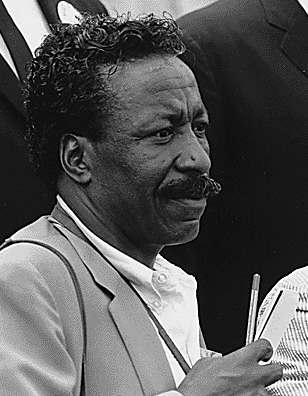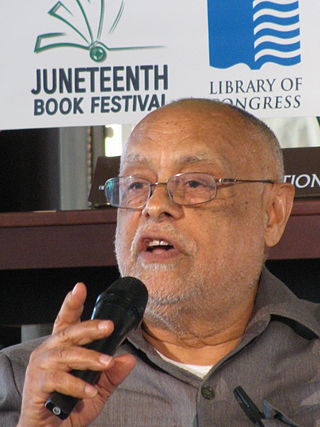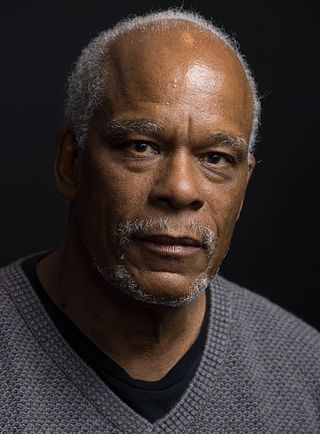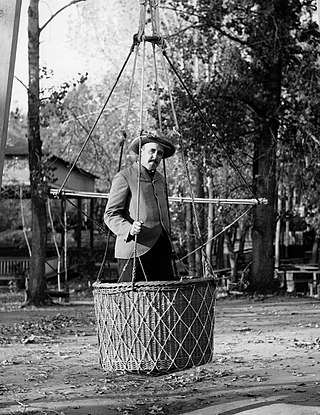Related Research Articles

The Birth of a Nation, originally called The Clansman, is a 1915 American silent epic drama film directed by D. W. Griffith and starring Lillian Gish. The screenplay is adapted from Thomas Dixon Jr.'s 1905 novel and play The Clansman. Griffith co-wrote the screenplay with Frank E. Woods and produced the film with Harry Aitken.

David Wark Griffith was an American film director. Considered one of the most influential figures in the history of the motion picture, he pioneered many aspects of film editing and expanded the art of the narrative film.

Oscar Devereaux Micheaux was an author, film director and independent producer of more than 44 films. Although the short-lived Lincoln Motion Picture Company was the first movie company owned and controlled by black filmmakers, Micheaux is regarded as the first major African-American feature filmmaker, a prominent producer of race films, and has been described as "the most successful African-American filmmaker of the first half of the 20th century". He produced both silent films and sound films.

Gordon Roger Alexander Buchanan Parks was an American photographer, composer, author, poet, and film director, who became prominent in U.S. documentary photojournalism in the 1940s through 1970s—particularly in issues of civil rights, poverty and African Americans—and in glamour photography. He is best remembered for his iconic photos of poor Americans during the 1940s, for his photographic essays for Life magazine, and as the director of the films Shaft, Shaft's Big Score and the semiautobiographical The Learning Tree.

Haile Gerima is an Ethiopian filmmaker who lives and works in the United States. He is a leading member of the L.A. Rebellion film movement, also known as the Los Angeles School of Black Filmmakers. His films have received wide international acclaim. Since 1975, Haile has been an influential film professor at Howard University in Washington, D.C. He is best known for Sankofa (1993), which won numerous international awards.
Political cinema, in the narrow sense, refers to cinema products that portray events or social conditions, either current or historical, through a partisan perspective, with the intent of informing or agitating the spectator.

Madame Sul-Te-Wan was the first African-American actress to sign a film contract and be a featured performer. She was an American stage, film and television actress for over 50 years. The daughter of former slaves, she began her career in entertainment touring the East Coast with various theatrical companies and moved to California to become a member of the fledgling film community. She became known as a character actress, appeared in high-profile films such as The Birth of a Nation (1915) and Intolerance (1916), and easily navigated the transition to the sound films.

Charlotte E. Burton was an American silent film actress.

Stanley Earl Nelson Jr. is an American documentary filmmaker and a MacArthur Fellow known as a director, writer and producer of documentaries examining African-American history and experiences. He is a recipient of the 2013 National Humanities Medal from President Obama. He has won three Primetime Emmy Awards.

The Lincoln Motion Picture Company was an American film production company founded in 1916 by Noble Johnson and George Perry Johnson. Noble Johnson was president of the company, and the secretary was actor Clarence A. Brooks. Dr. James T. Smith was treasurer, and Dudley A. Brooks was the assistant secretary. The company is known as the first producer of race movies. Established in Omaha, Nebraska, the company relocated to Los Angeles the following year. It remained in operation until 1923, closing shortly after announcing a final project, The Heart of a Negro. The point of the creation of Lincoln's was to eliminate the stereotypical roles of "slapstick comedy" in Hollywood at the time for Black actors and actresses. "best advertised and most widely known Race Corporation in the world" is the famous slogan for the company.
Midnight Ramble is a 1994 documentary about the early history of Black American movies from the period between 1910 and 1950. Known as "race movies", these films, traditionally independent of Hollywood, were made primarily by, for and about the black community. This documentary is a tribute to a film genre that lasted for more than 40 years, produced over 500 movies, and created a foundation for contemporary films from directors such as Spike Lee and Tyler Perry. James Avery narrates this exploration of the early black film industry. There is a mistaken assumption that "race films" began largely in reaction to D. W. Griffith's 1915 The Birth of a Nation. Nothing could be further from the truth. Race movies actually began around 1910 in Chicago in response to the Black Community longing to see themselves reflected on the silver screen via this new medium of film. Wanting to see themselves through their own eyes, on their own terms thus counteracting the Hollywood stereotypes within the American media. The film focuses especially on the work of Oscar Micheaux, considered the "Dean of Black American film", a controversial filmmaker who wrote, produced, and directed over 40 features, and tackled difficult social issues in Black America. It includes clips from films by a number of African-American directors of the period, which is very helpful since many of these films are difficult to find or unavailable. There are two versions of the title of the documentary, both referring to the same work. Initially released in 1994 as, Midnight Ramble: Oscar Micheaux & the Story of Race Movies It was re-released as Midnight Ramble: The Story of the Black Film Industry by PBS in 1995 The 1995 version also eliminates the David McCullugh introduction.

William D. Alexander was an American filmmaker. He made U.S. government sponsored newsreels for African American audiences. He later established his own production company, Alexander Productions, in New York City and became a film producer.

Anita Bush was an African American stage actress and playwright. She founded the Anita Bush All-Colored Dramatic Stock Company in 1915, a pioneering black repertory theatre company that helped gain her the moniker "The Little Mother of Colored Drama".

Foster Photoplay Company was a film production business in Chicago, Illinois. It was founded in 1910 by William D. Foster. It is widely considered to be the first film production company established by an African-American featuring all African-American casts. The company released a number of critically acclaimed films, including The Railroad Porter (1913), The Fall Guy (1913), and The Butler (1913). After the release of The Railroad Porter and The Fall Guy, the company became known for their films' slapstick-style comedy.
William D. Foster, sometimes referred to as Bill Foster, was a pioneering African-American film producer who was an influential figure in the Black film industry in the early 20th century, along with others such as Oscar Micheaux. He was the first African American to found a film production company, establishing the Foster Photoplay Company in Chicago in 1910. Foster had a vision for the African-American community to portray themselves as they wanted to be seen, not as someone else depicted them. He was influenced by the black theater community and wanted to break the racial stereotyping of blacks in film. He was an actor and writer under the stage name Juli Jones, as well as an agent for numerous vaudeville stars. His film The Railroad Porter, released in 1912, is credited as being the world's first film with an entirely black cast and director. The film is also credited with being the first black newsreel, featuring images of a YMCA parade. Foster's company produced four films that were silent shorts.

The film By Right of Birth premiered on June 22, 1921, in Los Angeles, California. This film is one of the few surviving films of the Lincoln Motion Picture Company, which is known as the first producer of race films and of such silent films as By Right of Birth. The company was founded in 1916 and in 1923 produced its last movie, The Heart of a Negro.

Harry Hale Buckwalter, sometimes credited as Harry H. Buckwalter or Henry H. Buckwalter, was an American photographer, journalist, photojournalist, and silent film director and producer.
Cinema of Sudan refers to both the history and present of the making or screening of films in cinemas or film festivals, as well as to the persons involved in this form of audiovisual culture of the Sudan and its history from the late nineteenth century onwards. It began with cinematography during the British colonial presence in 1897 and developed along with advances in film technology during the twentieth century.

African American cinema is loosely classified as films made by, for, or about Black Americans. They are an example of Black film. Historically, African American films have been made with African-American casts and marketed to African-American audiences. The production team and director were sometimes also African American. More recently, Black films featuring multicultural casts aimed at multicultural audiences have also included American Blackness as an essential aspect of the storyline.
Tony Langston was best known as "a tastemaker," an unusually insightful and persuasive African American arts critic who could tip "his readers off to a new wave of emerging Black talent" while also effectively arguing against racist tropes. As entertainment editor for the Chicago Defender, the city's largest Black newspaper, Langston wrote on theater, film and music, reviewing everything from the rare talent of Bessie Smith to the outrageous racism of Birth of a Nation for as many as a million weekly readers.
References
- ↑ "Doing the Right Thing: Black Film & TV in a Biased World". Micah Yongo. October 1, 2013.
- 1 2 3 4 5 6 Field, Allyson Nadia (May 22, 2015). Uplift Cinema: The Emergence of African American Film and the Possibility of Black Modernity. Duke University Press. ISBN 9780822375555 – via Google Books.
- ↑ Critic, Hal Boedeker, Sentinel Television (July 1998). "A SALUTE TO EARLY BLACK FILMMAKERS". OrlandoSentinel.com.
- ↑ Klotman, Phyllis Rauch; Cutler, Janet K. (1999). Struggles for Representation: African American Documentary Film and Video. Indiana University Press. p. 11-15. ISBN 978-0-253-21347-1.
- 1 2 Everett, Anna (August 14, 2001). Returning the Gaze: A Genealogy of Black Film Criticism, 1909-1949. Duke University Press. ISBN 0822326140 – via Google Books.
- ↑ "Silent Era : Progressive Silent Film List". www.silentera.com.
- 1 2 "Within Our Gates". silentfilm.org.
- ↑ "» Small Independents".
- ↑ "Booker T. Washington / Photo by Peter P. Jones, 3631 State St., Chicago". Library of Congress.
- ↑ "Documentary Film | Encyclopedia.com". www.encyclopedia.com.